27 Chapter Method Made Easy

Breakdown of The 27 Chapter Method
The 27 Chapter Method, also known as the 3 Act 9 Block 27 Chapter Method, was made popular by Kat O’Keefe, as a way to help guide writers on their story structure. Despite the technique generally known as the 27 Chapter Method, your novel can actually end up not having 27 chapters at all.
The idea of the 27 Chapter Method is to be able to identify important and specific plot points in your story, often as a broad starting point in the outlining phase.
The concept is to divide your story into 3 main acts: the start, middle, and end. Then, each of those acts are further divided into 9 blocks or chapters, hence the titular 27 chapters. However, we believe that it is more important for you to learn what each block should have and not restrict yourself into the actual 27 chapters.
The overview for all of the blocks for each act can be seen below.
Chapter Overview
ACT I
- Intro
- Inciting Incident
- Immediate Reaction
- Reaction
- Action
- Consequence
- Pressure
- Pinch
- Push
ACT II
- New World
- Fun & Games
- Old Contrast
- Build Up
- Midpoint
- Reversal
- Consequence
- Trials
- Dedication
ACT III
- Calm Before The Storm
- Pinch
- Darkest Point
- Power Within
- Action
- Converge
- Battle
- Climax
- Resolution
Chapter Descriptions
Having the outline might be less helpful than intended, so we’ll also include short descriptions of each block to guide you as you write your rough outline.
To further explain what each chapter is supposed to achieve, let’s try to follow the sample story of Sarah and Jane as they work together, Sarah as a new hire in the lab and Jane as a ghost after dying without ever reconciling with Sarah, and seek to avenge Jane’s death.
ACT I
- Intro: Introduce Hero and the ordinary world.
- We meet Jane and Sarah, two sisters that hate each other. Jane is an overachiever and Sarah is a slacker.
- Inciting Incident: A problem disrupts the Hero’s life that will kick off the rest of the story.
- Jane abruptly dies and her death was assumed to be a suicide.
- Immediate Reaction: The Hero deals with the inciting incident and/or the changes that result from the inciting incident.
- After Jane dies, Sarah’s tattoo starts hurting and she sees visions of Jane, telling Sarah that Jane was murdered. It seems Jane’s ghost is bound to Sarah’s tattoo.
- Reaction: Long-term reaction. The reader begins to understand just how the inciting incident will affect the Hero’s life.
- Sarah freaks out. She doesn’t want to be haunted by Jane. She tries to find ways to exorcise her sister, but nothing works (refusal to the call to action). The sisters determine that Sarah needs to help Jane pass on by dealing with her unfinished business.
- Action: The Hero decides to act and makes a decision that will impact the rest of the story.
- Sarah decides she must get herself into the elite program her sister was involved in.
- Consequence: The result of the decision made (see Action).
- Because of her decision. Sarah now has to study and prepare for the tests.
- Pressure: The Hero begins to feel the pressure of the task before them and is stressed.
- Sarah is taking the test and doing the interview, a pressured and stressful situation she did not expect to have.
- Pinch: Things get a little more complicated and the Hero wonders if the right decision was made. (see Action) A plot twist happens.
- It turns out that the test isn’t just a written test. There’s a hands-on portion that Sarah didn’t account for. Jane, the ghost sister, helps out at the last minute.
- Push: The Hero is pushed in a new direction.
- Sarah gets a tour of the lab. She meets new people that work there. She’s pushed into a new world.
ACT II
- New World: The Hero experiences a new world or situation.
- Sarah’s first days in the lab went pretty well, learning new things, spending time with new people, etc.
- Fun & Games: The Hero explores and interacts in the new world. This is a good place to build relationships, romantic or otherwise, and develop your character more.
- Sarah starts off a possible romance with someone in the lab who Jane, the ghost sister, hates.
- Old Contrast: The Hero compares the new world to the old, and is reminded of how much has changed.
- Sarah and Jane are fighting. Jane wants Sarah to focus on the work and not the guy she’s just met.
- Build Up: This is where you prepare for the major turning point in your story. There is some form of struggle, internal or external, that will motivate your Hero to take matters into their own hands.
- Sarah and Jane’s fighting gets to a boiling point, until Sarah claims that Jane decided to commit suicide to gain attention even after death. Jane gets hurt, decides to leave and not talk to her.
- Midpoint: The Hero encounters something that complicates their plans and motivates them to change the course of events.
- Sarah starts to find out new things on her own and then finally considers that Jane might have been murdered.
- Reversal: Everything changes.
- The sisters make amends and discuss the possibilities of who could have killed her.
- Consequence: The Hero reflects upon what has happened.
- Sarah decides to go to the police and try to report the murder. They don’t buy it, as they need proof and evidence.
- Trials: The Hero takes matters into their own hands and solves or works around the roadblocks that occurred. (See Reversal)
- Sarah is now wary of everyone in the lab. She starts to investigate everyone in the lab. She might be nervous that she’s the next target.
- Dedication: The Hero is now determined to overcome the overall issue.
- Sarah still finds no hard evidence but she’s dedicated to figuring it out.
ACT III
- Calm Before The Storm: The Hero finds a solution, but now must overcome doubt, or some other complication.
- Sarah builds on her romance with the love interest.
- Pinch: Plot Twist! Everything is worse than it was.
- Sarah finds out that the love interest is the murderer.
- Darkest Point: Everything seems lost.
- Sarah is betrayed. She starts to contemplate on who she should choose.
- Power Within: The Hero finds the courage and the strength to carry on.
- Sarah chooses her sister and musters up the courage to continue investigating.
- Action: The Hero takes action, and overcomes the plot twist, before taking on the overall issue again.
- Sarah starts to act coy around the murderer to lower his guard and find more evidence.
- Converge: Everything comes together: the main plot, the subplot(s), the conflict, etc. The big event is imminent.
- The sisters have fully fixed their relationship and are working together flawlessly.
- Battle: The Hero fights the villain and/or tackles the overall issue, full force.
- Sarah and Jane fight the nemesis with all they’ve got.
- Climax: The Hero either triumphs or succumbs to a fatal flaw.
- Sarah gets the proof she needs and the love interest is arrested.
- Resolution: Tie up all loose ends. Make sure the Hero has changed in some way.
- Jane finally rests in peace, and Sarah continues her career in the lab.
How To Use The 27 Chapter Method Template on LivingWriter
Now that you know how to use the 27 Chapter Method, you might be itching to put your new knowledge to the test. Luckily, LivingWriter, the best writing companion for authors and novelists, saw this very possibility ahead and has a neat template for those dedicated to using this method to structure their stories.
We’ll show you how you can get started on LivingWriter and the 27 Chapter Method:
1. When you open up LivingWriter, select 27 Chapter Method from the row of templates at the top of the page.
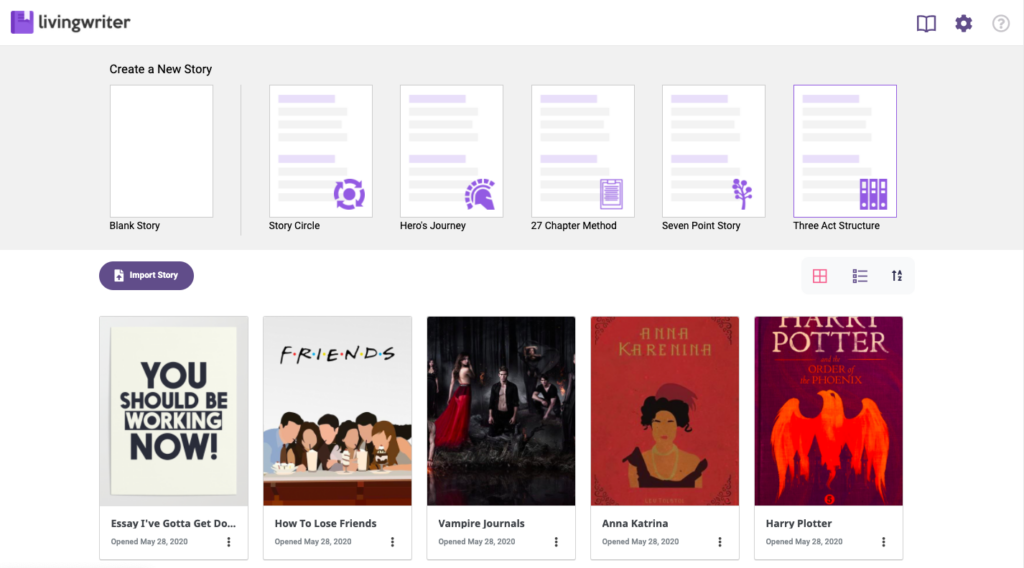
2. Once you’re inside, you’ll see three distinct sections: the outline section on the left, the main section on the middle, and the sidebar on the right. You’ll find the outline section pre-filled with the 3 acts and 27 chapters we just discussed above. Clicking through each chapter, you’ll also see the sidebar also pre-filled with basic information about each chapter.
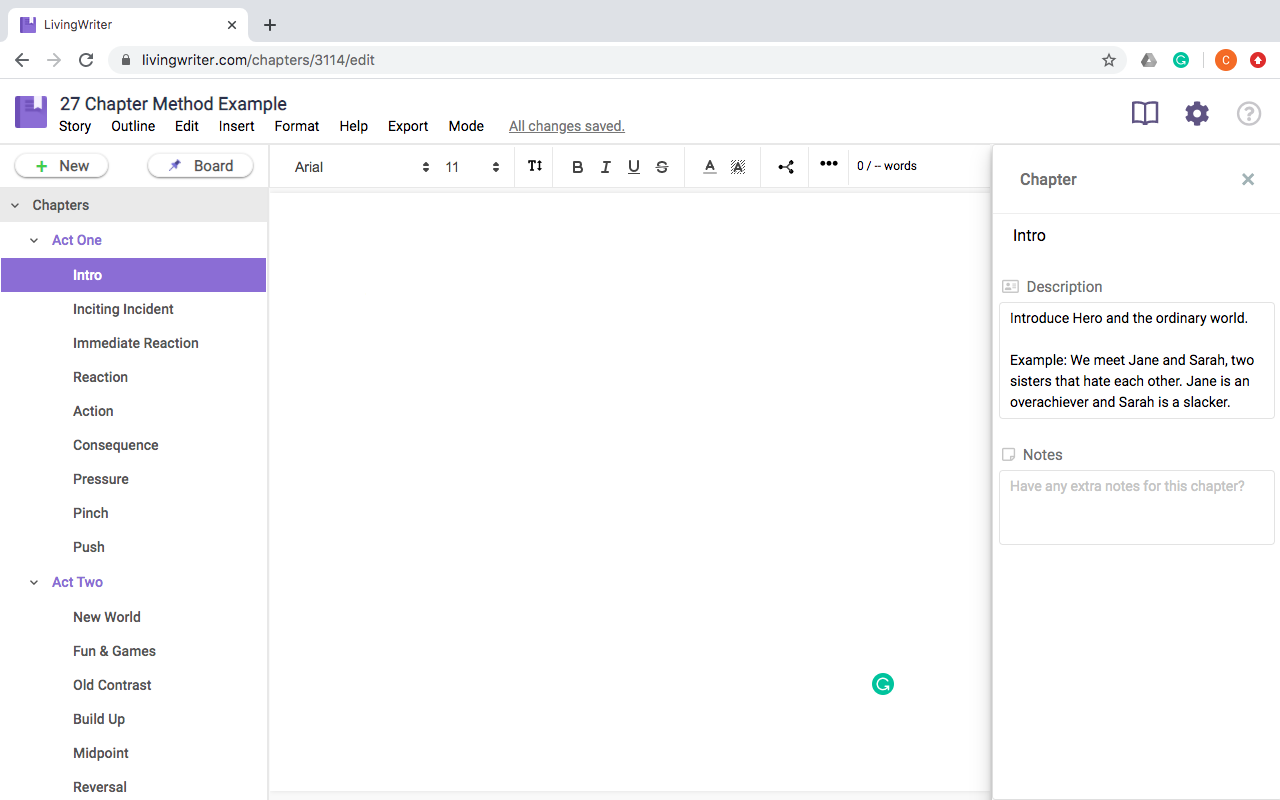
3. To work on the overall outline first, you can click on the Board button and then Outlines and Chapters. This will show you the three acts in blocks, designed similar to index cards pinned to a corkboard. You can fill these blocks with the general flow of your story, or a quick summary of each act.
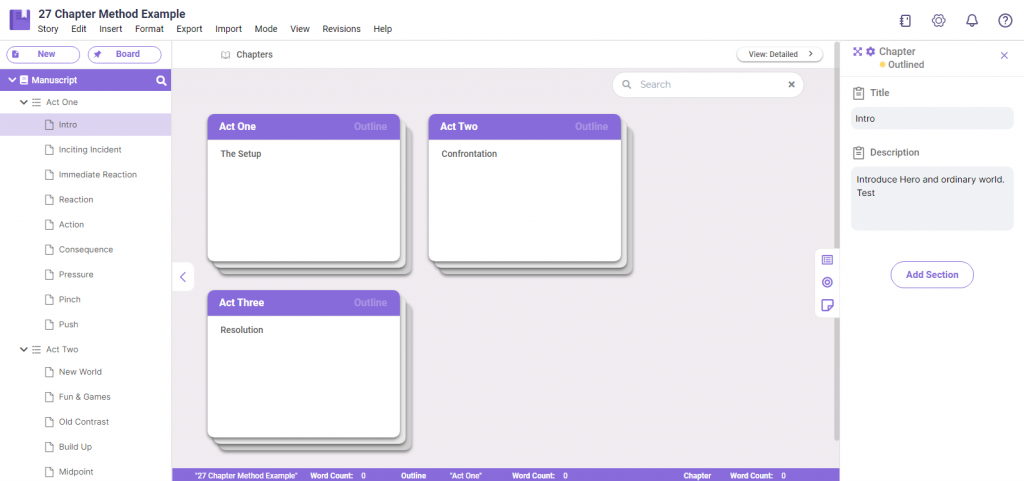
4. To work on the detailed outline, you can click on the upper right corner of each block to expand each act into its chapters. You can fill these blocks with the plot points for your story. These plot points will also appear in the sidebar when you go back to the main screen to write the story.
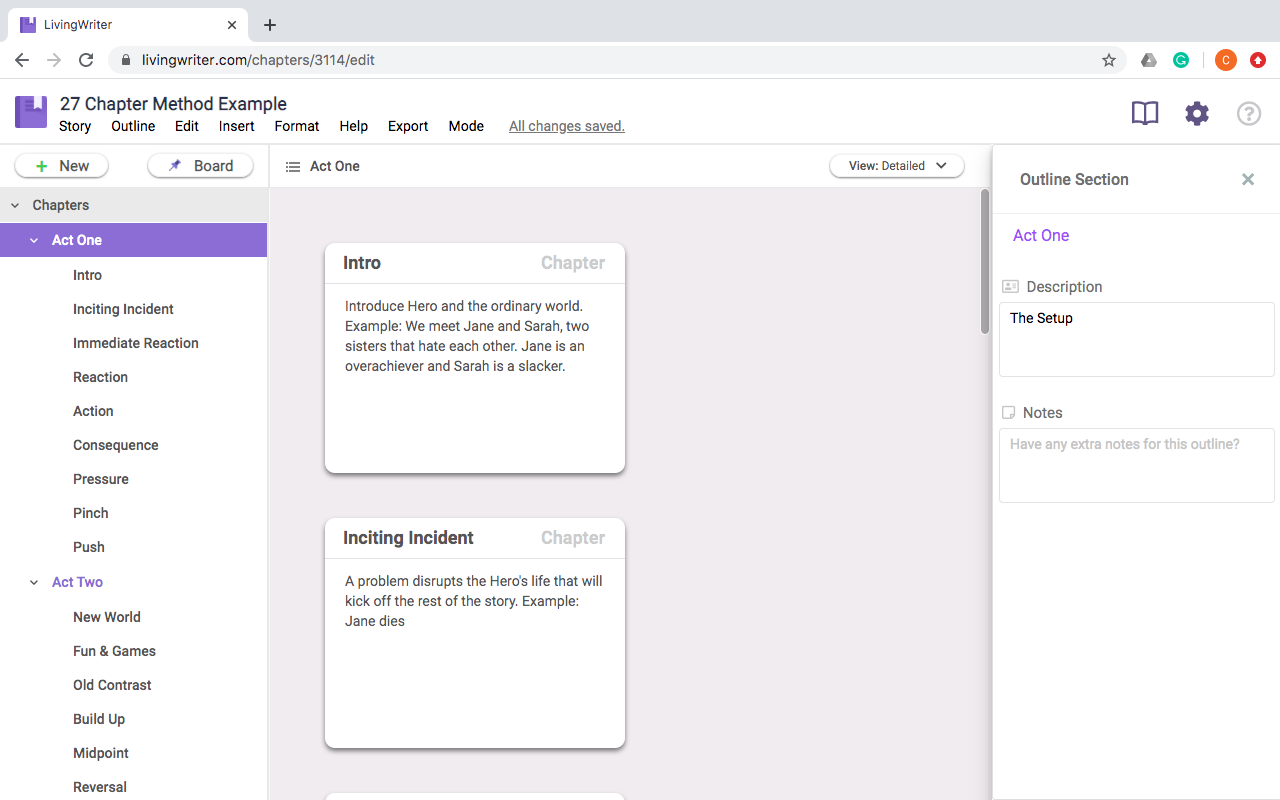
We also have a feature in the Outline and Chapters called Status, which allows you to keep track of the current status of each chapter. This is especially helpful as you can now easily go through your outline in LivingWriter and know which parts will need to be fixed, submitted, or edited.
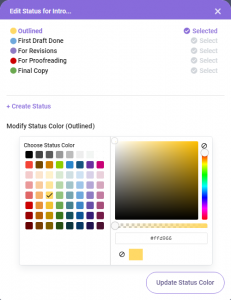
Reading this is sure to get your creative juices flowing! If you find Kat O’Keefe’s structure a bit too specific, you can check out other plotting methods like Dan Harmon’s Story Circle, and Dan Well’s Seven Point Story Structure.